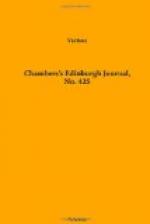The real grand thoroughfare of Venice is the Canale Grande—a wide curving street, which sweeps through a great part of the city. The principal palaces of the nobility, the superbest of the churches, and the best hotels, are placed along this water-street. As we moved along, Alessandro told us, in respectable French, the history of each great mansion, and what its owners had done in the history of the republic: a recital as intelligent and as accurate as could have been expected in a book. Most of these buildings have a melancholy, decayed look, being generally very old, and few of the owners being able to spend much in or on them. A few that look tolerably fresh, are found to be occupied by the post, the customs, or some other office, the insignia of which figure in gaudy colouring over the principal entrance. In connection with most of the palaces, the name of some architect of reputation is mentioned. They are wholly of marble; and, in many cases, round stones of a precious kind, or pieces of marble of a brilliantly veined character, are set in a species of framework in front, communicating a peculiarly rich effect. The least pleasing circumstance connected with these superb mansions, is their being so closely beset by other buildings. We saw only one or two which had any spare space associated with them, to form either a court-yard or a piece of garden-ground. Space is indeed the great want of Venice. Many of the canals, dividing lines of houses as lofty as those of the Old Town of Edinburgh, are not wider than the wynds of that celebrated city. And yet there we see the landing-places and entrances of magnificent mansions, though more frequently the houses on such narrow canals have the air of merchants’ stores and warehouses.
It would be vain to attempt a detailed description of one-half of the wonderfully beautiful old churches, palazzos, and other buildings, which we examined during this and the subsequent day. We were agreeably disappointed on the whole; for we had come with an idea that we should see only the shell of ancient Venice, and few of those works of art which used to be associated with its name; whereas the fact is, that all the most remarkable old buildings are entire, and in tolerable order; and scarcely a picture, or statue, or antique curiosity, has been lost during the political changes which the city has undergone. Doubtless, it is living Venice no more: it is Venice reduced to a museum—but what a museum! And here I must do the Austrian government the justice to say, that it appears to have a deep feeling of interest in the ancient monuments of the republic. It contributes handsomely for their maintenance; and no modern proprietor of an old palazzo can make any change in it, till he has satisfied a tribunal of taste, that the change will be in keeping with the antique and picturesque glories of the place.




